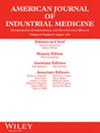A pilot study to identify factors associated with frailty within the World Trade Center general responder cohort
Abstract
Background
Given the significant exposures experienced by the World Trade Center (WTC) general responders, there is increasing interest in understanding the effect of these exposures on aging in this population. We aim to identify factors that may be associated with frailty, a clinical syndrome characterized by a decrease in one's reserve that has been linked to poor health outcomes.
Methods
WTC general responders enrolled in the WTC Health Program aged 50 and older provided informed consent. Validated frailty assessments, the Frailty Phenotype (with the Johns Hopkins Frailty Assessment Calculator) along with the FRAIL scale, categorized nonfrail from prefrail/frail. Fall risk, functional status, and cognition were also assessed. WTC variables, including an identified WTC-certified condition, were utilized. The risk of frailty was estimated using log binomial regression analysis. A 95% confidence interval (CI) was used to estimate the prevalence ratio (PR).
Results
One hundred and six participants were included; 38 (35.8%) were classified as pre-frail or frail. More of the pre-frail/frail group were obese (57.9% vs. 25%; p = 0.004) and had a WTC-certified condition (78.9% vs. 58.8%; p = 0.036). Obesity (PR = 2.43, 95% CI = 1.31, 4.53), a WTC-certified condition (PR = 1.77, 95% CI = 1.09, 2.89), and risk of falling (PR = 1.97, 95% CI = 1.01, 3.84) were independently associated with frailty.
Conclusions
Obesity and having a WTC-certified condition were found to be risk factors for frailty in our pilot study. Future work may focus on further identifying risk factors for frailty in the larger WTC general responder population.

 求助内容:
求助内容: 应助结果提醒方式:
应助结果提醒方式:


